________________________________________________________________________
 Manager need basic PR. This is true because department, division or subsidiary managers for a business, non-profit or association really DO need a dynamic yet workable blueprint for reaching those key outside groups of people who have a big say about how successful those managers are going to be.
Manager need basic PR. This is true because department, division or subsidiary managers for a business, non-profit or association really DO need a dynamic yet workable blueprint for reaching those key outside groups of people who have a big say about how successful those managers are going to be.
Unfortunately, a primary emphasis on communications tactics does not take the place of a well thought-out public relations plan for persuading your most important external audiences to your way of thinking, then moving them to take actions that lead to your success.
For example, a basic public relations blueprint like this one: people act on their own perception of the facts before them, which leads to predictable behaviors about which something can be done. When we create, change or reinforce that opinion by reaching, persuading and moving- to-desired-action the very people whose behaviors affect the organization the most, the public relations mission is accomplished.
Save the communications tactics for later when you need something to carry your message to the right external audience.
For now, think about an impactful public relations plan that can deliver the behavior results you want. I’m thinking of behaviors that produce real increases in capital gifts, new inquiries concerning joint ventures or strategic alliances, new waves of prospects or, especially, repeat purchases.
First step on this journey is one of discovery - just how do those key, outside audiences perceive your operation? This is vital, of course, because perceptions often morph into hurtful behaviors. Which suggests that you and the PR team assigned to you begin by interacting with members of those audiences, then prioritize them according to the impacts on your unit.
Here, you have a choice: you and your PR team can personally handle the perception monitoring and data gathering for your target audience because your PR folks are already in the perception and behavior business. Or, a large budget permitting, you can retain the services of a professional survey firm to do the job.
Once you decide who monitors and gathers the perception data, you need to ask the right questions of your audience members. “How much do you know about us, if anything? Do you have an opinion about our services or people. Have you ever had a problem with our operation?”
Stay on the lookout for negative responses such as misconcep- tions, rumors and false assumptions. And especially for inaccur- acies that could do damage because of the hurtful behaviors they can produce.
Now, with such perception data in hand, you’re ready to set your public relations goal. And this can be as direct as “clear up that misconception, neutralize the rumor, or fix that inaccuracy.”
Reaching that goal, however, requires just the right strategy. Since this is a matter of perception/opinion, you have only three choices: change existing perception, create it where none exists, or reinforce that existing opinion/perception.
Now, tap your best writer because you need to prepare a message effective enough to alter negative perceptions among members of your target audience. The message should be multifaceted if it is to do the job. It must be clearly written and fact-based as well as believable and thus, persuasive. Hopefully, it also will be compelling in its tone.
The challenge of delivering your message to the right ears and eyes falls to your communications tactics, and there are a ton of them. Everything from electronic magazines, consumer presentations, speeches and press releases to media interviews, newsletters, brochures and personal contacts. But make sure that each tactic you choose displays a track record of reaching folks similar to those you are trying to reach.
How will you know when you’re making progress? By going back to the field and re-monitoring the perceptions of members of that target audience. But there’s a new wrinkle the second time around. Your antennae will be up to capture signs of change in the offending perception - has that untruth, false assumption, hurtful misconception or damaging rumor been adequately addressed by your message and communications tactics? In other words, is perception among members of your target audience moving in your direction, thus signaling success?
Luckily, you can always speed up the process with additional communications tactics, and by increasing their frequencies.
By this point, what you will have done, of course, is put in place precisely the well thought-out public relations plan you need to persuade your most important external audiences to your way of thinking, then move them to take actions that lead to your success as a manager.
About The Author
Bob Kelly counsels, writes and speaks to business, non-profit and association managers about using the fundamental premise of public relations to achieve their operating objectives. He has been DPR, Pepsi-Cola Co.; AGM-PR, Texaco Inc.; VP-PR, Olin Corp.; VP-PR, Newport News Shipbuilding & Drydock Co.; director of communications, U.S. Department of the Interior, and deputy assistant press secretary, The White House. Visit his website here.
Article Source.
Tags: public relations basics, public relations for manager and companies, public relations
Public Relations Basics for Companies and Managers
________________________________________
 Manager need basic PR. This is true because department, division or subsidiary managers for a business, non-profit or association really DO need a dynamic yet workable blueprint for reaching those key outside groups of people who have a big say about how successful those managers are going to be.
Manager need basic PR. This is true because department, division or subsidiary managers for a business, non-profit or association really DO need a dynamic yet workable blueprint for reaching those key outside groups of people who have a big say about how successful those managers are going to be.Unfortunately, a primary emphasis on communications tactics does not take the place of a well thought-out public relations plan for persuading your most important external audiences to your way of thinking, then moving them to take actions that lead to your success.
For example, a basic public relations blueprint like this one: people act on their own perception of the facts before them, which leads to predictable behaviors about which something can be done. When we create, change or reinforce that opinion by reaching, persuading and moving- to-desired-action the very people whose behaviors affect the organization the most, the public relations mission is accomplished.
Save the communications tactics for later when you need something to carry your message to the right external audience.
For now, think about an impactful public relations plan that can deliver the behavior results you want. I’m thinking of behaviors that produce real increases in capital gifts, new inquiries concerning joint ventures or strategic alliances, new waves of prospects or, especially, repeat purchases.
First step on this journey is one of discovery - just how do those key, outside audiences perceive your operation? This is vital, of course, because perceptions often morph into hurtful behaviors. Which suggests that you and the PR team assigned to you begin by interacting with members of those audiences, then prioritize them according to the impacts on your unit.
Here, you have a choice: you and your PR team can personally handle the perception monitoring and data gathering for your target audience because your PR folks are already in the perception and behavior business. Or, a large budget permitting, you can retain the services of a professional survey firm to do the job.
Once you decide who monitors and gathers the perception data, you need to ask the right questions of your audience members. “How much do you know about us, if anything? Do you have an opinion about our services or people. Have you ever had a problem with our operation?”
Stay on the lookout for negative responses such as misconcep- tions, rumors and false assumptions. And especially for inaccur- acies that could do damage because of the hurtful behaviors they can produce.
Now, with such perception data in hand, you’re ready to set your public relations goal. And this can be as direct as “clear up that misconception, neutralize the rumor, or fix that inaccuracy.”
Reaching that goal, however, requires just the right strategy. Since this is a matter of perception/opinion, you have only three choices: change existing perception, create it where none exists, or reinforce that existing opinion/perception.
Now, tap your best writer because you need to prepare a message effective enough to alter negative perceptions among members of your target audience. The message should be multifaceted if it is to do the job. It must be clearly written and fact-based as well as believable and thus, persuasive. Hopefully, it also will be compelling in its tone.
The challenge of delivering your message to the right ears and eyes falls to your communications tactics, and there are a ton of them. Everything from electronic magazines, consumer presentations, speeches and press releases to media interviews, newsletters, brochures and personal contacts. But make sure that each tactic you choose displays a track record of reaching folks similar to those you are trying to reach.
How will you know when you’re making progress? By going back to the field and re-monitoring the perceptions of members of that target audience. But there’s a new wrinkle the second time around. Your antennae will be up to capture signs of change in the offending perception - has that untruth, false assumption, hurtful misconception or damaging rumor been adequately addressed by your message and communications tactics? In other words, is perception among members of your target audience moving in your direction, thus signaling success?
Luckily, you can always speed up the process with additional communications tactics, and by increasing their frequencies.
By this point, what you will have done, of course, is put in place precisely the well thought-out public relations plan you need to persuade your most important external audiences to your way of thinking, then move them to take actions that lead to your success as a manager.
About The Author
Bob Kelly counsels, writes and speaks to business, non-profit and association managers about using the fundamental premise of public relations to achieve their operating objectives. He has been DPR, Pepsi-Cola Co.; AGM-PR, Texaco Inc.; VP-PR, Olin Corp.; VP-PR, Newport News Shipbuilding & Drydock Co.; director of communications, U.S. Department of the Interior, and deputy assistant press secretary, The White House. Visit his website here.
Article Source.
Tags: public relations basics, public relations for manager and companies, public relations
Popular choices
- Non Gamstop Casino
- Mejores Salas De Póker
- Casino Non Aams
- Non Gamstop Casinos
- Siti Casino Online Non Aams
- Migliori Siti Casino Online
- UK Online Casinos Not On Gamstop
- Non Gamstop Casino Sites UK
- Non Gamstop Casino Sites UK
- UK Casino Not On Gamstop
- Casinos Not On Gamstop
- Online Casino
- オンラインカジノ
- UK Casino Not On Gamstop
- UK Casino Not On Gamstop
- Reputable Non Gamstop Casinos
- Casinos Not On Gamstop
- Best Non Gamstop Casinos
- Non Gamstop Casino
- Casinos Not On Gamstop
- Slots Not On Gamstop
- Non Gamstop Casino
- Casino Non Aams
- Casinos Not On Gamstop
- Betting Sites Not On Gamstop
- Casino Online Italia
- Casino En Ligne
- Casino En Ligne Belgique
- KYC 인증 없는 카지노
- Sites De Paris Sportif Fiables
Subscribe to:
Post Comments (Atom)






Comments (0)
Post a Comment